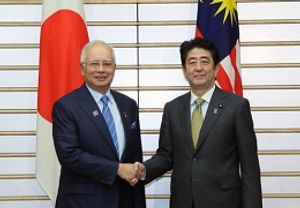This week, Malaysia received a coast guard patrol vessel from Japan. The development indicates both Malaysia’s close defense ties with Japan as well as the Southeast Asian state’s efforts to invest more in boosting its maritime security amid a range of threats.
Malaysia has a longstanding and deepening security relationship with Japan, with both countries sharing a number of concerns including China’s rising maritime assertiveness in the East China Sea and South China Sea. The strategic partnership that the two countries inked back in 2015 contained a heavy maritime security focus, and though details were left to be worked out, at the time there were indications that Japan would help boost Malaysia’s capabilities and that the two countries could even more towards more advanced transfers of defense equipment and technology (See: “Japan and Malaysia’s New Strategic Partnership”).
Last year, during Malaysian Prime Minister Najib Razak’s visit to Japan, reports had surfaced that Japan would provide Malaysia’s Maritime Enforcement Agency (MMEA) – the country’s equivalent of a coast guard – with two decommissioned offshore patrol vessels (OPVs). The vessels, to be provided at no cost, were scheduled be transferred to Malaysia during the first half of 2017 along with the necessary training and support (See: “Japan to Give Malaysia 2 Large Vessels During Najib’s Visit”).
The transfer of the decommissioned vessels were expected to help boost the MMEA’s growing but still limited capabilities as the agency moves towards a name change as the country’s Coast Guard (See: “Assessing Malaysia’s Coast Guard in ASEAN Perspective”). According to official estimates, the MMEA began with 59 vessels back during its establishment in 2005 but has since grown to include 255 ships.
Apart from the two OPVs the MMEA currently has, the vessels, along with three new OPVs being built in the country, would take the agency’s total to seven OPVs. Meanwhile, the first of the New Generation Patrol Craft (NGPC) the country received in March, named the KM Bagan Datuk, is equipped with 35 mm automatic cannons and an unmanned aerial vehicle that can carry out surveillance at an 80 nautical mile range for eight hours at a time. The NGPCs have been hailed as the MMEA’s largest, fastest, and most sophisticated vessels, with the Bagan Datuk having a range of 2000 miles and supporting a maximum crew of 41 at a speed of 12 knots.
The transfers of the two OPVs from Japan have been proceeding as scheduled this year. By early April, the first of the two vessels, the KM Pekan, had arrived and had begun operating following a launching by Najib in conjunction with the Langkawi International Maritime and Aerospace (LIMA) Exhibition in March. It was quickly placed on a series of tours of Sabah and Sarawak, including the areas under the East Sabah Security Zone (ESSZONE), and began conducting monitoring of the country’s maritime areas.
And on the morning of June 7, the second vessel arrived at Sepanggar naval base. The 28-year old vessel, which was named Ori and renamed KM Arau, weighs 993 tons and is 87 meters long, making it the largest MMEA vessel operating in Sabah and the second in the country after KM Pekan which is based in Kuantan. It is equipped with a helipad, radar and other communications and navigation systems that Malaysian officials have verified are still in top condition.
The KM Arau arrived a week after 25 MMEA crew and 13 Japanese crew began sailing from Inoshima, Japan on May 31. Prior to that, MMEA personnel had undergone two weeks of familiarization training in Japan.
MMEA’s director for Labuan and Sabah First Admiral Mohd Zubil Mat said that the vessel’s transfer was an indication of Japan’s contribution to the strengthening of Malaysia’s maritime capabilities.
“I am happy to note that since the establishment of MMEA, our cooperation with the JCG remain strong and they have been supporting us in matters related to maritime security,” he told reporters after touring the ship.
He added that the ship would be used for law enforcement and search and rescue operations, including cracking down on smuggling and encroachments. Malaysian officials have said before that the decommissioned vessels would be a boost for various reasons, including the fact that they can be out at sea for over a month at a time and were equipped with helipads to facilitate the landing of Malaysian aircraft that would not have to return to base for refueling.
The KM Arau is set to dock at the navy base before leaving for Port Klang on Friday for an official launching ceremony in Perlis and then returning to Kota Kinabalu where it will be based. The vessel will likely be shifted once the construction of a home base for the MMEA is completed, a project that is currently underway.
































